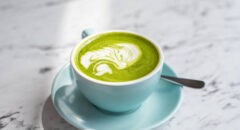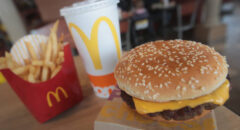Everyday we chow down on chemically produced foods that carry deadly poisons. Today when we eat meat, poultry and dairy, we eat the residue of everything the animal ate, including growth hormones, pesticides and contaminants.
Following are some of the harmful chemicals commonly found in our food and personal products, along with descriptions of what they are, where they’re found and why they’re bad.
Like what you’re reading? Then LIKE us on Facebook!
GMO Foods
Monsanto is an American multinational agricultural biotechnology corporation responsible for hazards such as Agent Orange. They are currently well known for Genetically Modified agriculture, owning nearly 90% of staple GMO crops such as corn, soy, and cotton. In independent studies GMO food has been linked to organ failure, and a recent Russian study has concluded near-total sterility in GMO-soy-fed hamsters by the third generation.
The question of whether or not genetically modified foods (GMO’s) are safe for human consumption is an ongoing debate that does not seem to see any resolution except in the arena of public opinion. Due to lack of labeling, Americans are still left at a loss as to whether or not what is on the table is genetically modified. This lack of information makes the avoiding and tracking of GM foods, very difficult. The top 10 worst GMO foods for your “do not eat” GMO foods list include corn, sugar, aspartame, papayas, canola oil, cotton oil, dairy, zucchini, and yellow squash.
The best advice: steer clear of them altogether.
Food Additives
When most of us think of harmful food additives we think of Monosodium Glutamate (MSG) which is still in many processed foods, but unfortunately MSG appears to be the least of the poisons now found in our food.
In 2008 Melamine was found in infant formula and some food products from China; the FDA went on record to say it was OK, despite sickening tens of thousands. Dangerous food additives appear in nearly all processed foods with even the most common food dyes Red 40, Yellow 5 and Yellow 6 being linked to cancer.
Most recently 92,000 pounds of frozen chicken was recalled because it contained “blue plastic pieces,” while McDonald’s Chicken McNuggets have been found to have “silly putty” chemicals in them. In fact, some researchers estimate that today’s chicken is so full of chemicals that it only contains 51% actual meat.
Fluoride
Not all fluoride is bad; only the type promoted by dentistry and added to our water and food supply.
Calcium fluoride is a naturally occurring mineral, while its synthetic counterpart, sodium fluoride (silicofluoride), is an industrial-grade hazardous waste material made during the production of fertilizer. Its past history includes patented use as rat poison and insecticide.
There are many blind- and double-blind studies that show sodium fluoride has a cumulative effect on the human body leading to allergies, gastrointestinal disorders, bone weakening, cancer, and neurological problems. In this case, the EPA’s Union of scientists issued a white paper condemning fluoridation of drinking water.
However, as a hazardous waste, it is extremely expensive to dispose of as such. And here might be a clue as to why this chemical, more toxic than lead and almost on par with arsenic, has been disposed of for our consumption.
Mercury
A dangerous heavy metal in its natural quicksilver form, but more so as the neurotoxin, methylmercury, released into the environment by human activity.
In both organic and inorganic form, mercury wreaks havoc with the nervous system — especially the developing nervous system of a fetus. It penetrates all living cells of the human body, and has been documented most as increasing the risk for autism.
This calls into question mercury’s use in dental fillings, vaccines, and just about anything containing high fructose corn syrup — a near staple in the American diet . . . including baby food. But the Corn Refiners Association naturally supports this chemical that is “dangerous at any level.”
Aspartame
Do you use a little Equal (also known as aspartame) to sweeten your drinks?
Aspartame, the king of artificial sweeteners, was allowed to the market in 1981 when the U.S. Commissioner of Food and Drugs, Arthur Hull Hayes, overruled FDA panel suggestions, as well as consumer concerns.
Aspartame is a neurotoxin that interacts with natural organisms, as well as synthetic medications, producing a wide range of proven disorders and syndromes. It is now nearly everywhere, moving beyond sugarless products and into general foods, beverages, pharmaceuticals, and even products for children. It recently has been renamed to the more pleasant sounding AminoSweet.
Personal care and cleaning products
Everyday household items and cosmetic products are applied directly to the skin, absorbed through the scalp, and inhaled. The list of common products and their chemical components is encyclopedic. The sum total of the overwhelming presence of these chemicals has been linked to nearly every allergy, chronic affliction, and disease known to man. Most recently, household cleaning products have been linked to breast cancer and ADHD in children.








